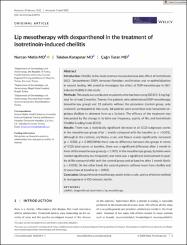| dc.contributor.author | Metin, Nurcan | |
| dc.contributor.author | Karapınar, Tekden | |
| dc.contributor.author | Turan, Çağrı | |
| dc.date.accessioned | 2022-05-17T11:08:04Z | |
| dc.date.available | 2022-05-17T11:08:04Z | |
| dc.date.issued | 15.04.2022 | en_US |
| dc.identifier.citation | Metin, N., Karapınar, T., & Turan, Ç. (2022). Lip mesotherapy with dexpanthenol in the treatment of isotretinoin‐induced cheilitis. Journal of Cosmetic Dermatology. | en_US |
| dc.identifier.issn | 1473-2165 | |
| dc.identifier.uri | https://doi.org/10.1111/jocd.14993 | |
| dc.identifier.uri | https://hdl.handle.net/20.500.12933/1027 | |
| dc.description.abstract | Introduction
Cheilitis is the most common mucocutaneous side effect of isotretinoin (ISO). Dexpanthenol (DXP) increases fibroblast proliferation and re-epithelialization in wound healing. We aimed to investigate the effect of DXP-mesotherapy in ISO-induced cheilitis in this study.
Methods
This study was conducted on patients who had been using ISO (0.5–1 mg/kg/day) for at least 2 months. Twenty-five patients who administered DXP-mesotherapy (mesotherapy group) and 33 patients without the procedure (control group, only ointment) participated in this study. All patients were prescribed only hamamelis virginiana distillate in ointment form as a lip balm. The efficacy of the treatment was interpreted by the change in lip balm use frequency, quality of life, and Isotretinoin Cheilitis Grading Scale (ICGS).
Results
There was a statistically significant decrease in all ICGS-subgroups scores in the mesotherapy group after 1 month compared with the baseline (p = <0.001), although in the controls, erythema, crust, and fissure scores significantly increased (p = 0.001, p = 0.002).While there was no difference between the groups in terms of ICGS total scores at baseline, there was a significant difference after 1 month in favor of the mesotherapy group (p < 0.001). In the mesotherapy group, lip balms were needed significantly less frequently and there was a significant improvement in quality of life compared with both the control group and at baseline after 1 month (both; p < 0.001). On the other hand, the control patients suffered more from cheilitis and dryness than at baseline (p < 0.001).
Conclusion
Dexpanthenol-mesotherapy seems to be a safe, and so effective method in management of ISO-related cheilitis. | en_US |
| dc.language.iso | eng | en_US |
| dc.publisher | Wiley | en_US |
| dc.relation.isversionof | 10.1111/jocd.14993 | en_US |
| dc.rights | info:eu-repo/semantics/embargoedAccess | en_US |
| dc.subject | Cheilitis | en_US |
| dc.subject | Dexpanthenol | en_US |
| dc.subject | Isotretinoin | en_US |
| dc.subject | Lip | en_US |
| dc.subject | Mesotherapy | en_US |
| dc.title | Lip mesotherapy with dexpanthenol in the treatment of isotretinoin- induced cheilitis | en_US |
| dc.type | article | en_US |
| dc.authorid | 0000-0002-6111-4314 | en_US |
| dc.department | AFSÜ, Tıp Fakültesi, Dahili Tıp Bilimleri Bölümü, Deri ve Zührevi Hastalıklar Ana Bilim Dalı | en_US |
| dc.contributor.institutionauthor | Turan, Çağrı | |
| dc.identifier.startpage | 1 | en_US |
| dc.identifier.endpage | 7 | en_US |
| dc.relation.journal | Journal of Cosmetic Dermatology | en_US |
| dc.relation.publicationcategory | Makale - Uluslararası Hakemli Dergi - Kurum Öğretim Elemanı | en_US |
















